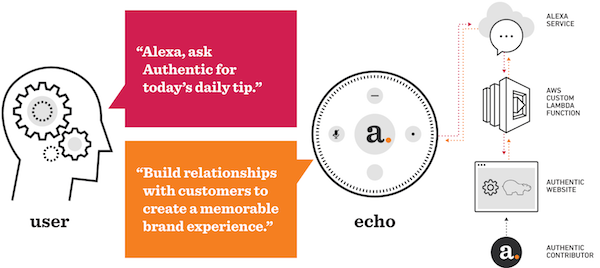This article is a guest post by Christen Daniels of Authentic. It was entered into The Hackies essay contest for the upcoming MarTech conference. Like it? You can register your vote in the contest by sharing it on social media, especially LinkedIn, Facebook, and Twitter.
This past holiday season our clients and partners received a little extra something in their stockings — and we don’t mean a few extra adult beverages, although the idea was born from a Friday evening office happy hour.
A casual conversation about AI and Amazon Alexa quickly turned into a “We can build our own skill” brainstorming session with lots of excitement and broad hand gestures.
With the holidays coming up quickly, we decided to send our clients and partners an Alexa-enabled Amazon Echo Dot along with our very own custom skill, the Authentic Digital Marketing Tip of the Day — or as we like to think of it, a personal digital strategist in a box dot.
Once the decision was made, our strategy and development teams developed the skill in record time — 10 days from ideation to Amazon approved skill. How is this possible, you ask? Well, our team clearly possess extreme super powers, and we’re only sort-of kidding.
How We Hacked Together Our Alexa Skill
Rather than letting time constraints discourage us, we decided to get creative with our approach to develop and deliver an MVP we could be proud of that used the systems and tools available. But, we didn’t stop there — we also wanted to be sure that the functionality would make it easy for the marketing team to update the skill with tips without requiring the help of our more technically inclined coworkers.
To get started building our skill, we had to create an Amazon Developer Account. Then, using the handy Amazon Alexa Developer portal, we began development. During this phase of the process we named our skill, provided a description, and added a few other key meta-data pieces such as a logo and an author.
Next, we had to develop our interaction model. Whether an end user would be talking with an accent, using a different language or mumbling “yeah” or the occasional “okay,” this was the part of the process where we defined the acceptable voice prompts and responses from Alexa. Once we determined the entry points of how the end user would respond or interact, it was time to build out the code that the Alexa Service would call on for the skill responses.
This code was developed using the Amazon Web Service (AWS) Lambda function. Lambda, which isn’t just the 11th letter of the Greek alphabet, but also the function that is found in a variety of programming language such as Node.js, Python and .NET. The code built using the Lambda function was then uploaded to the AWS infrastructure to be executed whenever our Authentic skill was invoked.
Now, for the good stuff. We’re going to let you in on a little secret — the difference between our Authentic Alexa skill and other skills, isn’t just in our name but how our content is managed.
We utilized Hippo CMS, the content management system that powers our website to expose a REST API in order to retrieve data from the CMS back-end to serve up content for our skill. This functionality was made possible by Java but harnessed the features of Hippo by providing content-as-a-service (CaaS). This functionality allows for content to be added by CMS contributors through the normal Hippo Admin User Interface. Pretty cool, right? We like to think so, as it has allowed our marketing team to quickly and easily enter and update tips on demand.
Another great feature of the AWS infrastructure is that we want to be sure to highlight, is that the developer console allows for testing with sample phrases prior to submitting for approval — which our team had a lot of fun testing at the office.
This function was particularly helpful in determining that our skill held up to Amazon’s approval process and guidelines, our developers really do possess some kind of super power (it works!), and innovative ideas really can be discovered during an after-work happy hour.
All jokes aside, we’re happy to report that the long hours and short turnaround time paid off and our Authentic skill went live to serve up a daily dose of digital marketing know-how to anyone who cares to utter, “Alexa, ask Authentic for today’s daily tip.”
What did you think of this article as an entry in The Hackies essay contest for the upcoming MarTech conference? If you liked it, you can register your vote in the contest by sharing it on LinkedIn, Facebook, and Twitter.





Very interesting read!
@Christen: I’d be curious: why did you choose to build this as a “Custom Skill” vs. a “Flash Briefing Skill” which would seem even easier for this kind of use-case?
“Good question — the Flash Briefing skill would have worked well, but we choose a Custom Skill so that we could define our own experience, be able to evolve it, and demonstrate the ability to connect with the Hippo CMS. With a custom skill, we can easily add to it, as we’re clear to add new request types to the skill. Plus, the CMS connection allows our back-end users to easily add new content.”